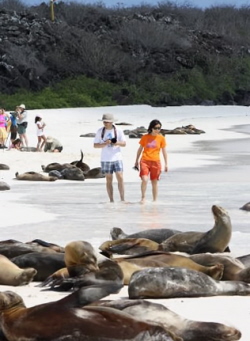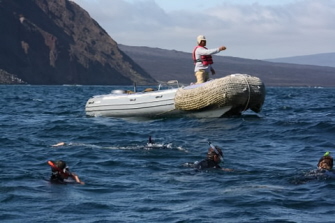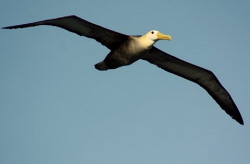Story and Photographs by Susan Farewell

I had heard that going to the Galápagos Islands was a life-changer. But I never fully understood what that meant until I went myself.
Like every eager visitor, I had looked forward to seeing the wildlife. I had read that the species differ from one island to the next and that the islands are home to the only remaining colonies of certain species. I had also heard that that the birds and animals are not afraid of people. What I didn’t expect, however, was that the wildlife practically introduce themselves to human beings. wildlife practically introduce themselves to human beings.
This was apparent on day 1, when my daughter and I were on our first shore excursion, from the M/V Eclipse, the expedition ship we were traveling on. Within moments of stepping foot on Santa Cruz Island, we were greeted by a Galápagos Mockingbird and a Yellow Warbler who not only came within inches of our group but hung around as we made our way to an inland lagoon to see pink flamingoes.
In the days that followed, we found ourselves routinely stepping around prehistoric looking iguanas (sometimes piles of them), slumbering sea lions and blue-foot boobies with babies (Aren’t mothers supposed to be protective of their offspring?). And it wasn’t just on terra firma. In our snorkel gear we came face to face many times with sea lions, sea turtles and even swam among um..er…sharks, big sharks.
I’ve been on several safaris and wilderness trips, but never have I had the opportunity to see wildlife at such close range, as we did on and around these volcanic islands. This “we-were-here-first” attitude so many of the creatures seem to have is a result of the Ecuadorian government’s commitment to keeping the footprint of humans to a minimum. People are objects of curiosity to them rather than threats.
Unlike some expedition cruises where you only observe the scenery from the deck of your ship, here we spent a lot of time actually exploring. Each day, we’d anchor offshore and take pangas (inflatable motor boats) to two different island sites where we’d hike through the volcanic landscapes, explore lava tunnels and comb white-sand beaches which were  sometimes overwhelmingly crowded with sea lions. sometimes overwhelmingly crowded with sea lions.
What we couldn’t see on foot, we’d explore by panga, once going into a mangrove ecosystem that was a refuge for sea turtles and rays. We kayaked up close to pelicans, penguins and flightless cormorants who hung out in the spectacular rock formations. We also snorkeled a lot, sometimes right from beaches, other times by dropping into the deep Pacific waters right off the pangas. Most fun was playing with the sea lions underwater. Apparently, they love it when you imitate them, rolling around, doing somersault-like submarine acrobatics.
 At night, we’d navigate from one island to another, and while we had been warned it could be rough at times, we never once felt seasick. The evenings always included a briefing by one of the naturalists, who would fill us in on what we’d do and see the next day. These half-hour sessions included smartly edited slide shows filled with easily digestible information. I felt as if I had gone back to school, only there was no homework and no tests. I also observed my 13-year-old daughter lapping up the information about how the islands were formed and how they played such a pivotal role in Darwin’s theory of evolution. It was such a pleasure to watch her, along with the other younger members of the voyage, mesmerized by what they were learning. At night, we’d navigate from one island to another, and while we had been warned it could be rough at times, we never once felt seasick. The evenings always included a briefing by one of the naturalists, who would fill us in on what we’d do and see the next day. These half-hour sessions included smartly edited slide shows filled with easily digestible information. I felt as if I had gone back to school, only there was no homework and no tests. I also observed my 13-year-old daughter lapping up the information about how the islands were formed and how they played such a pivotal role in Darwin’s theory of evolution. It was such a pleasure to watch her, along with the other younger members of the voyage, mesmerized by what they were learning.
 It’s one thing to learn about volcanoes and evolution in school. It’s another thing entirely to walk on a path Darwin himself hiked along. To see a baby waved albatross, a member of the only colony of these birds on the planet. To watch a giant tortoise grazing on cactus—knowing that these old timers can live as much as 150 years. It’s one thing to learn about volcanoes and evolution in school. It’s another thing entirely to walk on a path Darwin himself hiked along. To see a baby waved albatross, a member of the only colony of these birds on the planet. To watch a giant tortoise grazing on cactus—knowing that these old timers can live as much as 150 years.
It is being here that you really start to understand why so many people consider going to the Galápagos a trip of a lifetime.
|

